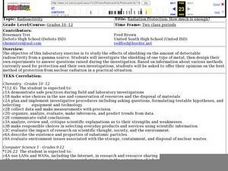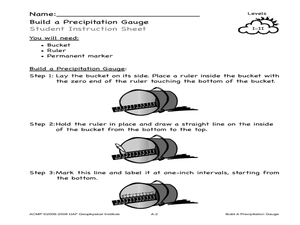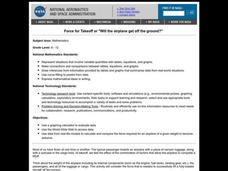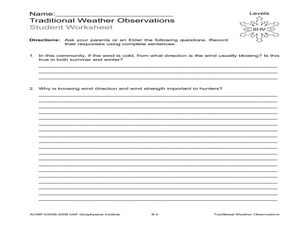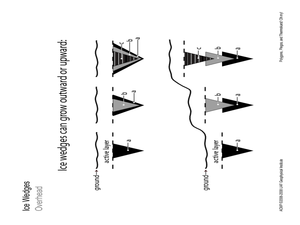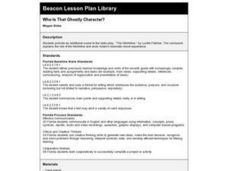Curated OER
Wind
Learners build an anemometer and measure wind speed. In this wind speed instructional activity, students build an anemometer using the student instruction sheet. Learners visit the Alaska windspeed website and look up the wind speed...
Curated OER
RADIATION PROTECTION: HOW MUCH IS ENOUGH?
Pupils study the effects of shielding on the amount of detectable radioactivity from a gamma source. They investigate the shielding of one type of metal, then design their own experiments to answer questions raised during the investigation.
Curated OER
Weather Timeline
Students create a timeline of historical weather events in Bedfordshire, England. In this local weather lesson, students interview elders, research the Internet and newspapers to gather information about weather events of the past. the...
Curated OER
Build a Precipitation Gauge
Students build a precipitation gauge. In this weather lesson, students follow step-by-step directions to build a precipitation gauge that can be used to measure snowfall.
Curated OER
Identifying Sea Ice
Students study different types of sea ice and interview an Yupik elder or local hunter. In this sea ice lesson plan, students study the native language for sea ice terms. They interview an elder from Alaska's northern coast about their...
Curated OER
Tour of the Frozen Ground
Students discuss and observe permafrost features in their local community and compare and contrast these features with those described in a novel. In this permafrost lesson, students invite an elder from their community to discuss...
Curated OER
Math: Will The Airplane Get Off the Ground?
Students use data from real-life models to calculate and compare the force required for an airplane of a given weight to become airborne. They use a graphing calculator to evaluate data and use the World Wide Web to access data.
Curated OER
Alliteration
Students write and illustrate a sentence which names a letter of the alphabet. The sentence should have subject, verb, describing words, and incorporate alliterative techniques.
Curated OER
American Literature Unit Two
Students prepare for and respond to literature selections. This package includes nineteen lessons from the American Literature, A New Nation: 1750-1850 series, each covering a different reading selection. Pre-reading and response...
Curated OER
Traditional Weather Observations
Students explore traditional methods of weather observation. In this weather lesson, students interview grown-ups regarding wind. Students learn how winds can help forecast weather.
Curated OER
Seasons
Students name the 4 seasons, discussing the weather, plant life, animal life and and activities of each. Students read the book titled, "Hello Arctic," and and discuss changes in seasons that accompany the story. Students complete...
Curated OER
Subsistence Calendar
Learners create a subsistence calendar for seasonal activities in their community. In this seasonal activities lesson plan, students research the four seasons in their community and write down the activities to do in that season.
Curated OER
Go Glacier Go!
Students create a model of a glacier and observe how it moves. In this landforms lesson, students learn what a glacier is, build a model glacier and observe how it moves in a manner that more closely resembles a liquid than a solid.
Curated OER
Polygons, Pingos, and Themokarst! Oh MY!
Learners complete activities to learn about the common land features in Alaska. In this land study lesson, students study an overhead for permafrost features. Learners define ice wedge polygons, thermokarst, and pingos. Students also...
Curated OER
Walking on Frozen Ground
Students listen to an Elder speak about permafrost structures in their area. For this permafrost lesson plan, students listen to the guest speaker, take a tour outside to view permafrost structures, and draw them.
Curated OER
Water, Water Everywhere
Students explore water. In this water cycle lesson, students conduct a scientific investigation that requires build a terrarium models of the earth. Students record their observations of the changes regarding water in the terrarium.
Curated OER
Using Newsprint as a UV Detector
Students investigate the effects of UV radiation. In this earth science lesson, students explain how the time of day relate to UV abundance on Earth. They determine if weather affects the amount of UV that Earth receives.
Curated OER
Water Quality
Students analyze water quality and turbidity of collected samples. In this physics lesson, students conduct tests to identify the suspended particles in the samples. They explain how human activities affect water quality.
Curated OER
Who Is That Ghostly Character?
Eighth graders listen to a taped version of the radio play, "The Hitchhiker". They write a conclusion to the play and work with a partner to evaluate it before a final revision.
Curated OER
The Cycle of Life
Eighth graders search for rites of passage in their own lives and study rites of other cultural groups in Louisiana and around the world. They assess how to recognize moments of importance in people's lives and find meaning in the stages...
Curated OER
Personal Ecosystem
Learners build an aquatic ecosystem using large glass pickle jars. In this ecology lesson plan, students build and ecosystem then observe and collect data on the habitats. In this long term project learners observe a...
Curated OER
Google Earth Scavenger Hunt
Students complete activities to learn how to use Google Earth and study Alaska. In this Google Earth lesson, students complete a Google Earth scavenger hunt to find facts about Alaska. Students complete two worksheets for the topic.
Curated OER
Weather
Young scholars study seasonal weather and interview elders in their community about how weather affects traditional activities. In this seasonal weather lesson, students talk about the seasonal, traditional activities they participate...
Curated OER
Cloud Types
Students examine cloud types. In this cloud lesson, students identify cloud types, observe clouds and collect data, and analyze data to identify the most common cloud they observe overhead during the course of a month.



